Pontevedra: a model of transformation and perfect tourist destination
Hello once again everyone! In today's post I'm going to talk to you about the capital of my province, and both have the same name. For those who've studied Latin, (and for those who haven't!), the place name Pontevedra is Latin (pontis veteris). It refers to an old bridge that suspends over the bed of the river Lerez. Today there are 7 bridges, no more, no less.
I know Pontevedra like the palm of my hand. It's well connected, by road and railway. If you arrive at one of the Galician airports, there are some good highway roads. Nowadays, you can arrive from Bueu in a blink of an eye. Before the opening of the new road (a highway), you would often be stuck in significant traffic jams at the Marin junction. You used to have to take the coastal road, if you entered through Aguete, and left the internal road. You'd be enjoying the panorama and it's succession of beautiful beaches (Portocelo, Mogor), until the entrance to the Naval School, but the traffic jam further ahead was monumental, and there was no way to avoid it.
The Naval School takes up quite an extensive area of space. From the car, you can see different buildings, the villas for the officials, the installations and sports resources. The King tends to come here every 16th July (alone, or in company) to preside of the Swearing In of the Flag and "presentation of despatches". It's also during the summer when the school ship Juan Sebastian Elcano visits our waters. From Bueu you can see it, and if you can even get on the vessel if you have permission, or know someone on it.
Pontevedra is 21 kilometres from Bueu. At the end of the 20th century is was a "city of provinces", a bit grey and downcast. This was during the days of the streets being open to traffic and tobacco fumes in the cafes. It needed renovating, a "reshaping". It's an administrative city, and that creates character. The average Pontevedran (if I can say that), is extremely polite. The commercial activity it had, and currently has is very important. Pontevedra is unavoidable touristic destination, now more than ever.
I will start by saying that the change applied to this town has received and deserved many awards. I won't list all their winnings, but the most relevant. Pontevedra have the National Prize for Galician Culture, awarded by the Xunta de Galicia (the collective decision-making body of Galicia) in 2008. Also they received the DUBAI AWARD from ONU HABITAT in 2014 which was collected in Dubai by the Mayor, Miguel Lores. Additionally, they were given the Center for Active Design which was awarded by the city of New York (won in 2015 and was delivered in Hong Kong), which is known as a Smart Mobility City.
The change has been produced in stages, little by little. It took decisions, means and a project. They removed the humanisation from the streets, starting with the pedestrianisation, the lanes and walkways, which made the city far more pleasant and healthy for the people who live there. Pontevedra is a city of plazas and camellias. The promenade, the social life, enjoying the local food, and going shopping are now all far more inviting. They have a cultural schedule for the whole year, and they are considered to be "the most comfortable city to live in Europe". The central area is so tidy and in order that you can wander round on foot without any difficulty. There's a bullring, eight cinema rooms in Vialia, a conservatoire. There's a university campus, which is dependant from the University of Vigo. There's also a Regional Centre for the Universidad Nacional a Distancia (which is an extension of a university in Colombia, an Open University), which is in the Montoporreiro area. The courses to study on this campus are rather limited though. I have to highlight the Department of Fine Arts, two of whose professors are friends with my parents. And what are they both? Basque, of course!
WHAT IS THERE TO SEE?
I have prepared a summary of everything you have to see during your first visit to Pontevedra, Pontevedriña, "Ponte" or "PTV" to its friends. It's impossible to be thorough, in such a way that I will join you in doing one of my trips. You won't be disappointed, so don't lower your expectations! Pontevedra's citizens are growing, with new people settling in. Maybe soon you'll be doing the same thing!

If you're coming by car, remember that the whole city has underground car park services. From Bueu, you have to go along the edge of the estuary along its final section, and then follow along the river. This whole riverbank has become a spectacular promenade. The pedestrians can walk a considerable distance along it, strolling or jogging. You'll see some remains of the old fishing neighbourhood, the sport port and the nautical club. Without moving from your seat, you'll understand why Pontevedra is a "city of bridges". They make a ring around the lower part of the city, "in order to cross to the other side". They're all very different, each one having a clashing style with the other. The "Puente de los Tirantes" and "Puente de las Corrientes", and they are the most modern two bridges in Pontevedra.
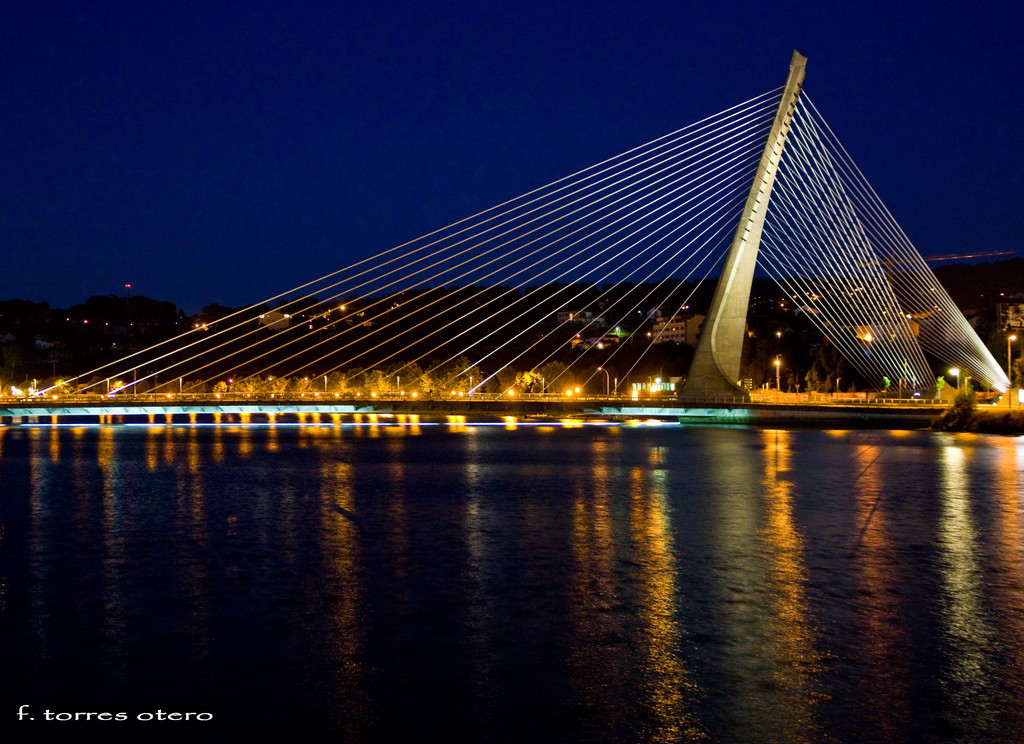
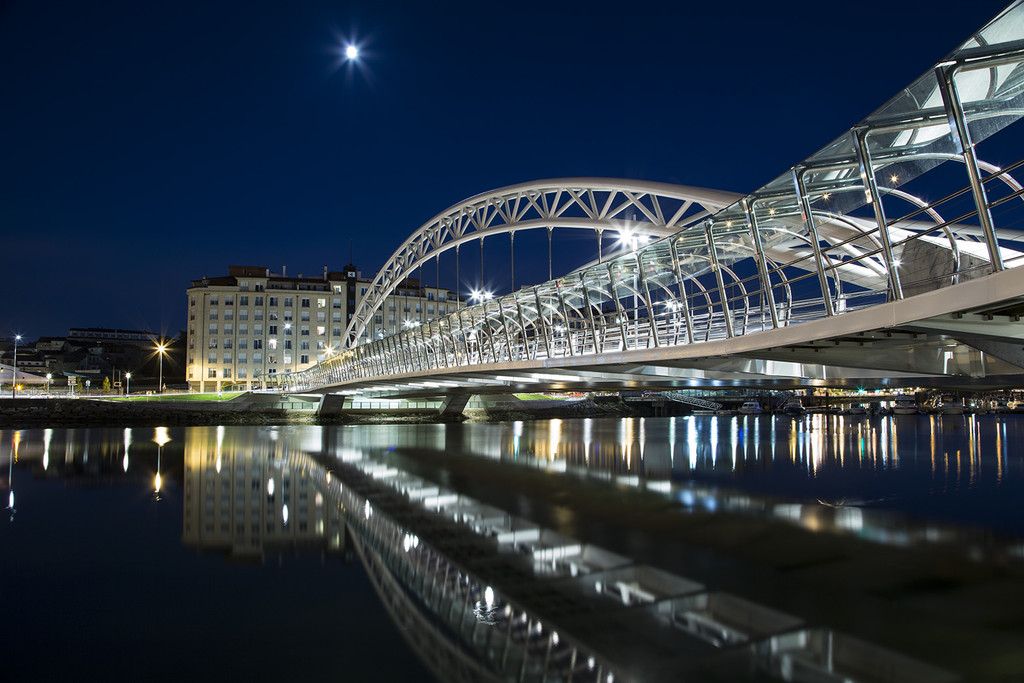
The last one is the most recent (making it the 7th), and the cost of it amounted to, (officially! ) 7.3 million euros. My favourite place to park is the Plaza de Abastos. It's very comfortable and has spacious ceilings. The exit is situated right in the heart of the old town. The first thing you'll see is how the abandoned or buildings for sale live together, they are works of art in motion, and magnificent works of rehabilitation. You'll see a stretch of fenced in housing, completely covered in greenery and moisture. If you observe the first entrance to the left, you'll find yourselves in the Praza da Pedreira. You can't forget the Pazo de Mugartegui which was recovered as the headquarters of the "Regluation Council of Rias Baixas, (the wine), Designation of Origin". They additionally have exposition conferences and concert rooms.
Continue walking until the Praza Mendez Nunez. You will be knocked to your feet at the bronze statue of the very same Ramon Maria del Valle Inclan, who was painted pink in an absurd act of continued vandalism.
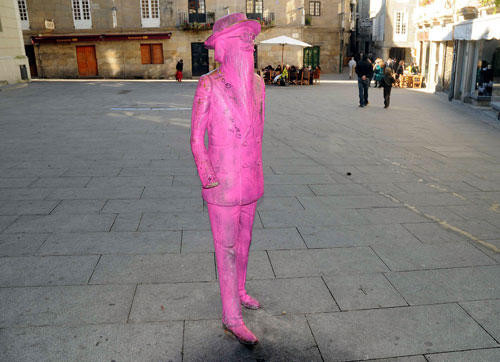
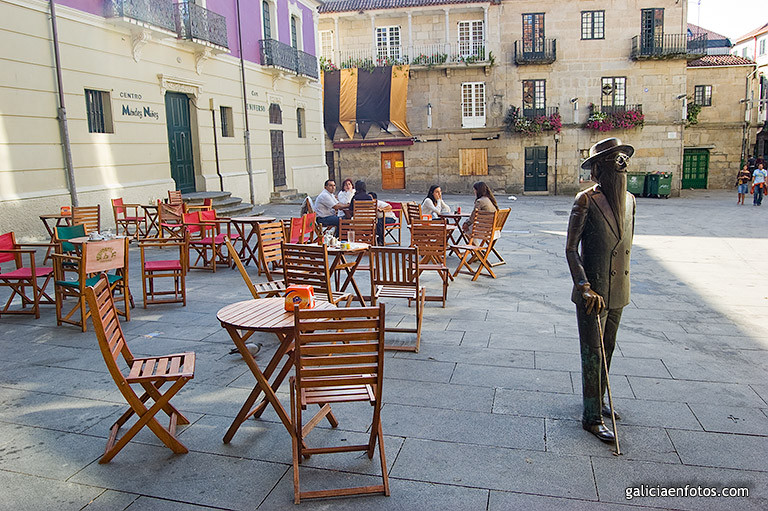
Lovers of architecture won't know where to look! The best thing to do is double round to the left, to the Praza de Verdura. It's almost completely filled with little tables from the bars, pubs and tapas spots. There's so much atmosphere, especially when the weather's good. On rainy days, there are also tables under cover. At night, they turn on the lights (they're all the same throughout the city and are in the strange shape of "syringes"). Illuminated, the city looks even more beautiful and intimate, with one of the many fountains you'll see at every corner. If you fancy having a bite to eat, you have to choose somewhere: Bar Os Maristas, Taperia Os Carballos, or Asador Furancho de Bora will offer you little octopus dishes, empanadas, padron peppers... Right there, in front, on the Rua Conde de San Roman, I recommend that you stop to admire the centenary pharmacy. It's very well known by the Pontevedrans and has been photographed by millions of visitors. On its wall, you can read: F. Vda. Enrique Eiras Puig. You'll see that on many of the plaques with the street names are named twice. These are the old and new names, with the following formula (just in case some lost soul has no clue), "a street... formerly... ".
The commerce in Pontevedra is changing gradually. Some of the numerous old businesses live on in harmony with the new ones. A lot of them are enchanting. Some of the oldest shops are closing down little by little, due to retirement or discrepancy, a little bit of everything. If you like Vintage, you can't miss Lagasca on Rua Manuel Quiroga. They sell incredible clothes at the most incredible prices. Passing through this street, you'll see two local spots, the Town Bookshop. There are a few more bookshops, new ones, such as Cronopios or Metafora and others that are more traditional, such as Libreria Paz. And one step further on Glorieta de Compostela, you have Libreria Baroja on the street Calle Palamios which draws in continued activity, at the book presentations in particular. It might seem absurd to you to talk about something that doesn't exist but, who doesn't remember the Libreria Michelena? It was on the street of the same name and it was an necessary guide in the city, with two exits onto different streets and an immense space inside. I have loads of stories and books that I bought there, with the label on the first page.
The street Calle Conde de San Roman (where we had stopped), leads into Praza da Ferreria. Upon arrival, you must stop, and breathe in some fresh air. It's an open space fenced in by beauty at all sides. The whole plaza in itself is both a meeting and celebration spot: book fairs, concerts, etc.
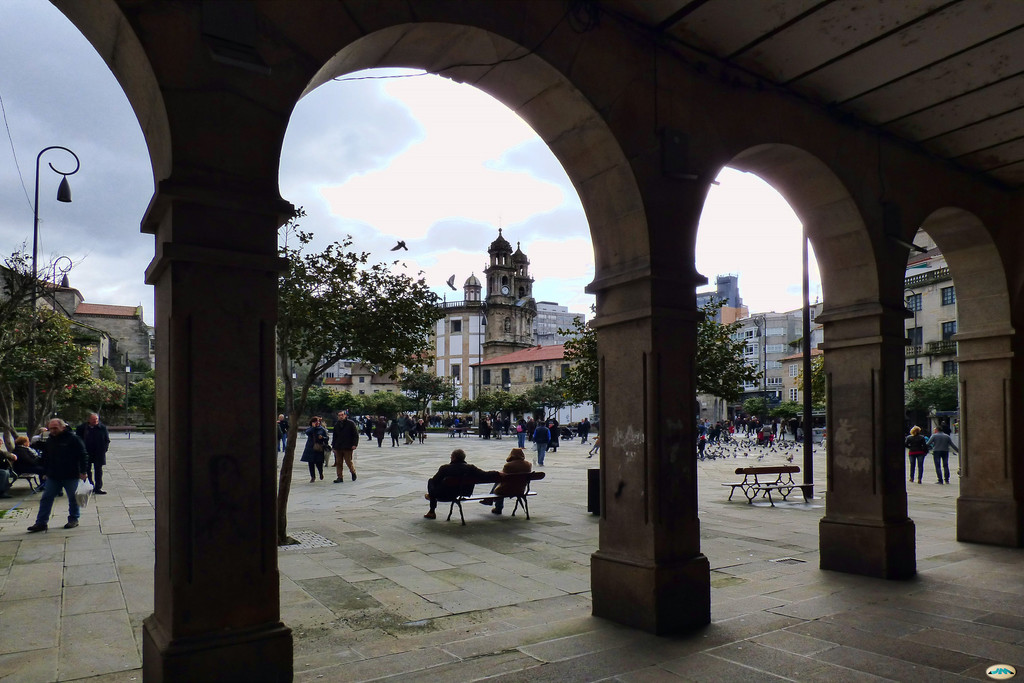
You'll see children playing, doves, chestnut sellers in the winter, people chatting in cafes. There are a lot of cafes, but I will mention the three most peculiar ones. I'll start with the Cafe Bar Carabela, which has remained without any changes since its opening in 1946. It has tables sheltered from the rain and a patio around a pond. You can have a bite to eat, a tortilla, empanada, squid rings. I recommend, above everything else, the natural lemon slush. For those who look for convenience, comfort and a "chic" atmosphere, I recommend Cafeteria San Francisco, decorated with no expense spared. They have super comfortable sofas, and books just in case you get bored. Warning: after midnight, coffee and teas cost 3 euros. Just in front, is the Savoy, unmistakable because it has an upstairs and downstairs. They organise musical evenings, especially with jazz. You have to spin around and look at the monumental ensemble behind you. I'm talking about the Tax Office (I'm not joking! ), which was the Convent of San Francisco. The church is attached, with its rosette on the wall. From above, they overlook the Gardens of Casto Sampedro and its magnificent fountain. From there you can see the silhouette of the Santuario de la Peregrina. It's the only one in the whole of Spain that has this circular form, in the shape of a scallop. The pilgrims from the Camino de Santiago take a break at this point. A trivial fact for you: it was designed by the architect Arturo Souto.
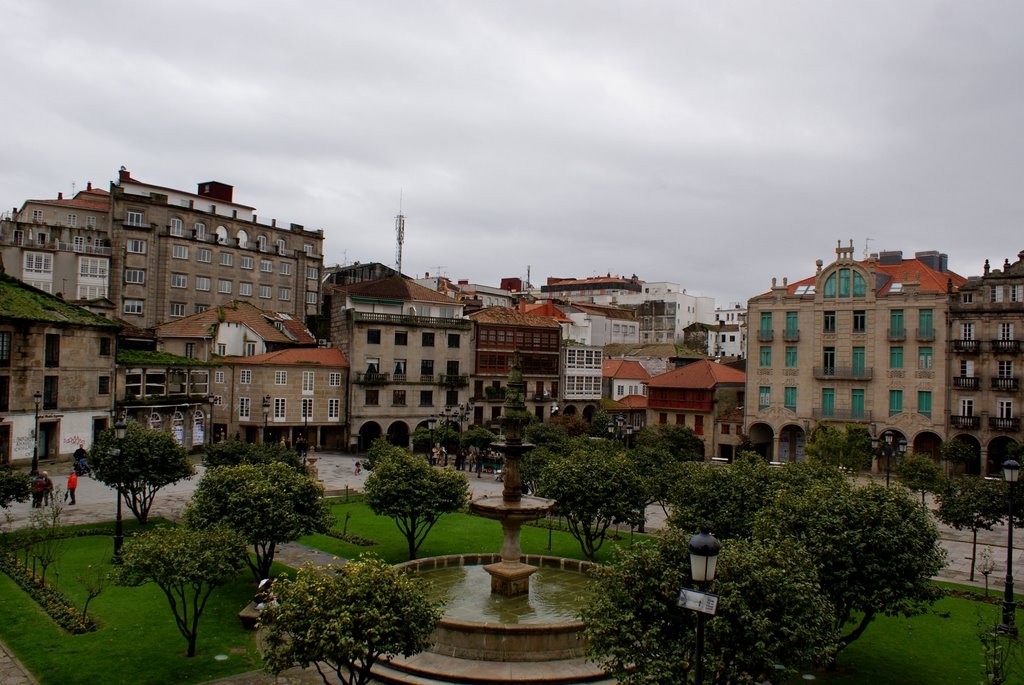
If you look at the view with your back to the temple, you'll see the legendary Calle de la Oliva, which is a very successful shopping street, that has various galleries on it. I recommend that you make a stop to try a lovely ice cream. Veneto can't be missed and it advertises itself as a Artisinal Ice Cream Parlour. A few metres away from Veneto you'll find a ceramic Sargadelos shop. It also has an art gallery and a conference room. Before going inside, you can admire the windows of one of the shops you like. I'm referring to Torrado that sells material for painters and craft lovers. Carrying straight on, you'll arrive to the Plaza de San Xose. All of this constitutes the hub of cultural importance. It consists of two blocks: the Center of Maiores of the Abanca Foundation, the exhibition venue attached to the Modern Café. It's a real wonder that you can't miss. On the other side of the Plaza is the main building. They often use the auditorium for theatre shows or conferences. The last time I went was to see Concha Velasco, who received a standing ovation for her work in "Olivia y Eugenio". In the centre of this plaza, they've erected an ensemble of, what they call, "living statues". These are very popular in Europe as cultural facilities. Not one person doesn't take a photo, and they even pose between the five gentlemen. The represent the intellectuality that frequents Cafe Moderno, which is truly called this because in 1903 they offered... Coffee! which they ground. It's obligatory, (no one would forgive me if I couldn't do it), to name the five talking points of the plaza. They, in order, Manuel Quiroga, Carlos Casares, Valentin Paz Andrade, Alexandre Boveda, Castelao and Ramon Cabanillas. Full stop.
If you carry on walking to the end of the street and you double round to the right, you'll arrive at La Alameda, another one of the spots that I like the most. The shape of the Avenue will catch your eye, outlined by gigantic palm trees which surprise first time visitors as they give out an unexpected tropical atmosphere. On the other side are some educational institutes, the music stage, the Ruins of Santo Domingo. If we continue straight on, we'll come out into the Calle Xeneral Gutierrez Mellado. It's a pedestrianised area where the rows of palm trees continue, making a passageway. I know it all by heart because I passed my driving test in this city. Well, they compete with the modern lampposts, all of which are spectacular. When we reach the end of the street and double to the left, we'll arrive at the City Hall. From there, we then return to the old town, to the Main Theatre, which leads out to the Liceo Casino. It's at this point that I'll recommend Jaqeuyvi, although I haven't been in a long time because I went with my parents. It means, ham, cheese and wine and their speciality which is (or was), the "jaqeuyvis", whose recipe I cannot reveal, of course. Some steps further down, is the Livingstone bar. You can't miss it: it's the only building of luxury there. As we arrive in the old area, I'm going to make another recommendation. To have dinner, visit the Verdun, founded in 1909. The place has several rooms, and the menu is very varied. I recommend the crunchy salad, and for dessert, death by chocolate! The glass cabinets they have in the background will catch your eye: in them, they exhibit a huge collection of authentic tin toys.
Another central and cultural concept of the city is the amount of buildings that have a Museum attached. We have to add a whole ensemble of annexes to the original headquarters, on the street Calle Pasanteria. It has various rooms where you can see some objects that date back to the prehistoric ages, until the 20th century. The collection of jewels make it clear how much (or how little) fashion changes. When I went there for the first time, they had already added the Pazo Garcia Florez. It's a stately home that I would love to have a look around, from top to bottom. You can see a kitchen, how it was then, even with a room with an open fire and a stone bench for gossip. To wander around the maze of a house is an absolute delight. It's like "snooping around" a journey through town. Hiding a surprise, at the bottom of a very steep and difficult staircase: they have reproduced the official chambers of the Spanish ironclad Numancia (an armored frigate bought from France during the 1860s). It's an airtight space, with small curtains that cover the ox's eyes. Even the floor is not quite straight, which gives the impression that you're moving with waves beneath. There's a Sixth Building, at a certain distance away, but well integrated. It's connected through the National Archives through two tall passages. It has an avant-garde air to it, breaking the tradition of the other buildings. They use it for all kinds of events: exhibitions, concerts, book fairs. It has a cafe-restaurant, La Ultramar Taberna Atlantica. I've never been, but it looks really good.
If what you want is to get to know Pontevedra during a more festive time, I recommend two dates for you to visit on: the week of celebrations in honour of La Peregrina (careful! She isn't the patron saint), in August. And Feira Franca, the first weekend in September. There are concerts during the evening, the celebration begins in the bullring, where you'll see the best pyrotechnic show, with fireworks. The other big festival is Feira Franca. The whole city time travels into its history, and the Medieval Ages come out on top.
The people from Pontevedra and the rest of the visitors, thousands of people, throw themselves out onto the streets, whether they're dressed up or not. Different strokes for different folks. You'll see parades, jugglers, town criers, workshops, banners and stalls with old-fashioned trades and their products. Both celebrations draw in a multitude of people, so it's not recommended for those who love the peace and quiet. If you can't come on these dates, Pontevedra will have a solution. It's a good time to cross over the bridges and visit the monasteries : Poio and Lerez.
To end this ridiculously long post, (sorry, I didn't want to leave anything out! ), I have to mention a "con" amongst the "pros". I'm referring to the business ENCE, which produces cellulose at the foot of the estuary. It has a chemical plant, ELNOSA, that extends all the way to the boundary of Pontevedra with Marin. Nowadays, (it's an old dilemma), its presence in the estuary is argued between supporters of it and the naysayers. Workers argue against their own jobs. The ecologists, and not just them, highlight the environmental impact. It's precisely in these proximities where you'll find the ascent to Paso de Lourizan, a marvel that I dedicated a whole post to before. Harmful or not, it really does produce a strange and unpleasant smell that spreads throughout the whole zone. It even reaches Bueu, depending on which way the wind blows. I'll leave you lot to debate about it now, as I'm putting an end to it. This has been my route through Pontevedra, a city that fascinates me. There is so much more, so I apologise for anything I've missed. As you already know, leave you comments and questions below, and remember to share! Whatever you want!
Photo gallery
Content available in other languages
Want to have your own Erasmus blog?
If you are experiencing living abroad, you're an avid traveller or want to promote the city where you live... create your own blog and share your adventures!
I want to create my Erasmus blog! →























Comments (0 comments)